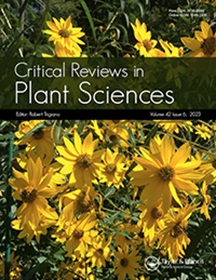Jasmonates as Emerging Regulators of Plants Response to Variable Nutrient Environment
IF 6
2区 生物学
Q1 PLANT SCIENCES
引用次数: 5
Abstract
Abstract Jasmonates (JAs) are known for their roles in plant defense and growth regulation. In recent years their roles in nutrient uptake and homeostasis have been explored. Regulation of nutrients uptake is crucial to maintain their optimum level in normal and deficient conditions. Under the deficiency of different nutrients, plants show unique responses like altered root growth, remodeling of root system architecture (RSA), induction of nutrient uptake-related genes, activation of nutrient transporters, and nutrient reallocation. JAs have been shown to regulate these responses in the variable availability of macro-and micronutrients. Emerging evidences revealed that in response to deficiency of macronutrients, such as nitrogen (N), phosphorous (P), and potassium (K+), JA biosynthesis pathway is activated. JA signaling pathway has been implicated in regulating nutrient deficiency-related transcription factors, transporters, and various facets of RSA for optimum plant development. In addition, JA pathway cross-talks with other phytohormones like auxin and ethylene for improving plant growth and adaptive response under nutrient deficiencies. In this review, emerging evidences and the latest developments on involvements of JAs in macro- and micronutrient uptakes, homeostasis, deficiency response, and plant development are discussed.茉莉酸盐作为植物对可变营养环境响应的新兴调节剂
摘要茉莉酸盐(Jasmonates, JAs)因其在植物防御和生长调节中的作用而闻名。近年来,它们在营养吸收和体内平衡中的作用已被探讨。在正常和缺乏条件下,营养摄取的调节对于维持其最佳水平至关重要。在不同养分缺乏条件下,植物表现出根系生长改变、根系结构重塑、养分吸收相关基因诱导、养分转运体激活、养分再分配等独特的响应。JAs已被证明在不同的宏量和微量营养素可用性中调节这些反应。新发现的证据表明,JA的生物合成途径被激活,以应对氮(N)、磷(P)和钾(K+)等宏量营养素的缺乏。JA信号通路涉及调节营养缺乏相关的转录因子、转运体和RSA的各个方面,以实现植物的最佳发育。此外,JA通路还与生长素、乙烯等其他植物激素相互作用,改善植物在营养缺乏条件下的生长和适应性反应。本文综述了JAs参与植物宏量和微量营养素吸收、体内平衡、缺乏反应和植物发育的新证据和最新进展。
本文章由计算机程序翻译,如有差异,请以英文原文为准。
求助全文
约1分钟内获得全文
求助全文
来源期刊
CiteScore
12.90
自引率
1.40%
发文量
15
审稿时长
>12 weeks
期刊介绍:
Critical Reviews in Plant Sciences focuses on presenting in-depth and up-to-date reviews of timely and/or cutting-edge subjects in the broad discipline of plant science, ranging from molecular biology/biochemistry through the areas of cell biology, plant pathology and physiology, genetics, classical botany, and ecology, to practical agricultural applications. Articles in the journal provide an up-to-date literature base for researchers and students, pointing the way towards future research needs. The journal is also a significant source of credible, objective information to aid decision makers at all levels.

 求助内容:
求助内容: 应助结果提醒方式:
应助结果提醒方式:


